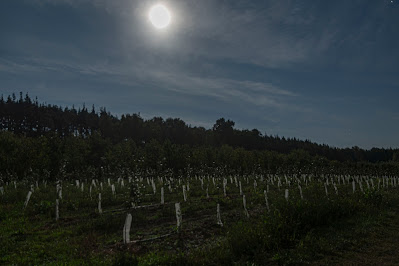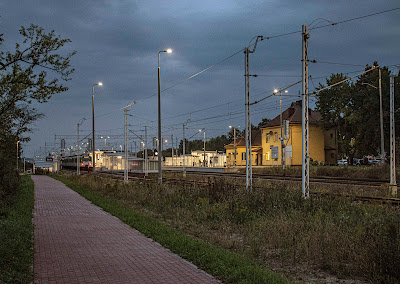The last week (today excepted - it rained for a while) gives me mixed feelings. On the one hand, who could complain about six unbroken days of cloudless skies and heat (26C - 28C maxes) - dry heat, without mosquitos - at the end of September? Except that it is the end of September. We are a week past Equinox, night is longer than day, and the forecast for Tuesday, 3 October, suggests a daytime high for Warsaw of 26C. (If it exceeds 25.9C - then that will be another temperature record broken this year.)
While we are benefiting from the gorgeous weather in terms of our samopoczucie (perceived mental/ physical wellbeing), we must also be aware that climate change is real and is unfolding before our eyes. Tracking data is one thing, and we must ground our understanding of climate change on scientific data, but the subjective memory - that can play tricks - is important too. Septembers in Warsaw do happen to be sunny. However, yesterday, Poland's meteorological institute announced that September 2023 was 3.9C hotter than the average temperatures for the month. [An excellent breakdown of September temperature this year in Poland here.]
Here in Chynów, the apple harvests are in full swing, trees full of fruit - another good season, despite the relative lack of rainfall. We have also been spared any extreme weather events - no tree-uprooting winds, no flash floods, and no thunderstorms yielding golf-ball-size hailstones. Yet when the weather doesn't play the cosmic trickster, folk keep to their old ways - tractors standing in fields or orchards, engines idling, burning diesel and pumping emissions into the air. The farmer fails to see the need to turn the engine off. Same at the level crossing - when the barriers falls, it's around three minutes until the train passes and the barriers rise. Yet only the newest cars which have engines that automatically cut out when stationary aren't spewing CO2 into the air.
New York City hasn't been so lucky, hit with flash floods that led to a state of emergency being declared yesterday. Yet because Poland has to date escaped the wrath of climate change, the subject is not an issue in the discourse leading up to the parliamentary election in two weeks' time.
The extra days of summer warmth mean I've not had to switch on my heating (last September I first felt uncomfortably cold enough to do so on the 19th); my electricity consumption is down 18% compared to the same period next year. So - the warmer it gets, the less energy we consume?
Now that we're in the dark half of the year, let me turn my attention to hours of sunlight. Plentiful between the equinoxes, it starts to plummet.
Below: annual sunshine hours, Warsaw. Note the steep falling-off that occurs between October and November - this is the 'hammer of darkness' effect that I've noted (click here on on label below right). October sees more than twice as many hours of sunshine than November; December's the worst by far, followed by January.
Trains of thought, insights and 'voices'
This time four years ago:
Parliamentary train at West Ealing station
This time five years ago:
Progress in Jakubowizna
This time seven years ago:
Miedzianka by Filip Springer
This time eight years ago:
Out of the third, into the fourth
This time nine years ago:
Inverted reflections
This time ten years ago:
Observations from London's WC1
and Observations from the City of London
This time 11 years ago:
Civilising Jeziorki's wetlands
This time 12 years ago:
Warsaw's Aleje Jerozolimskie
This time 14 years ago:
Melancholy autumn mood in Łazienki
This time 15 years ago:
Autumn gold, Zamienie
This time 16 years ago:
Flamenco Sketches - Seville















































